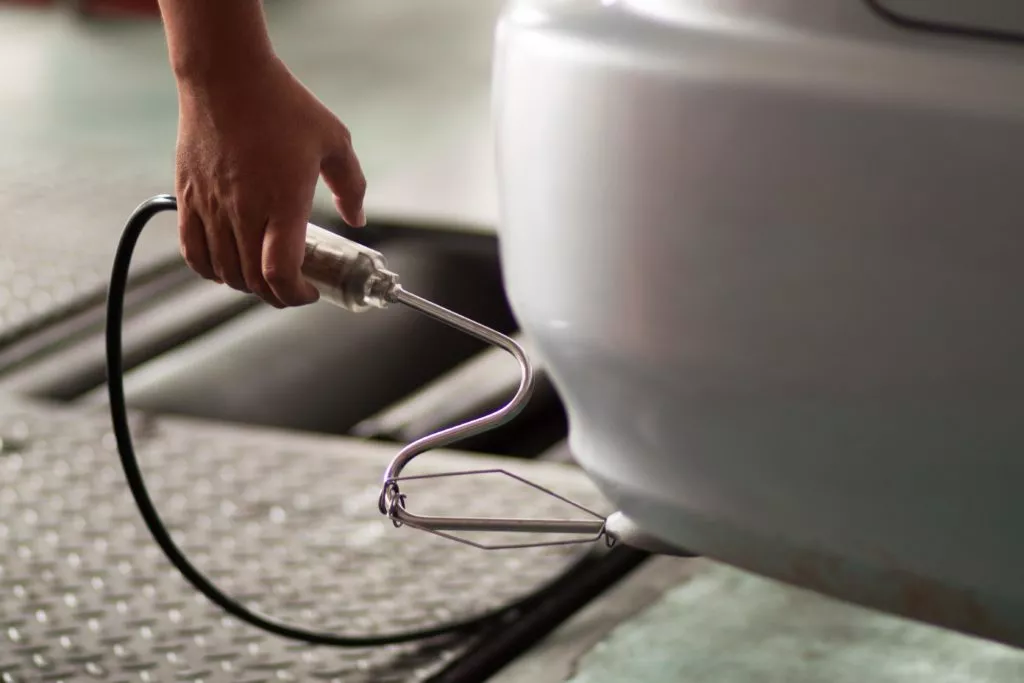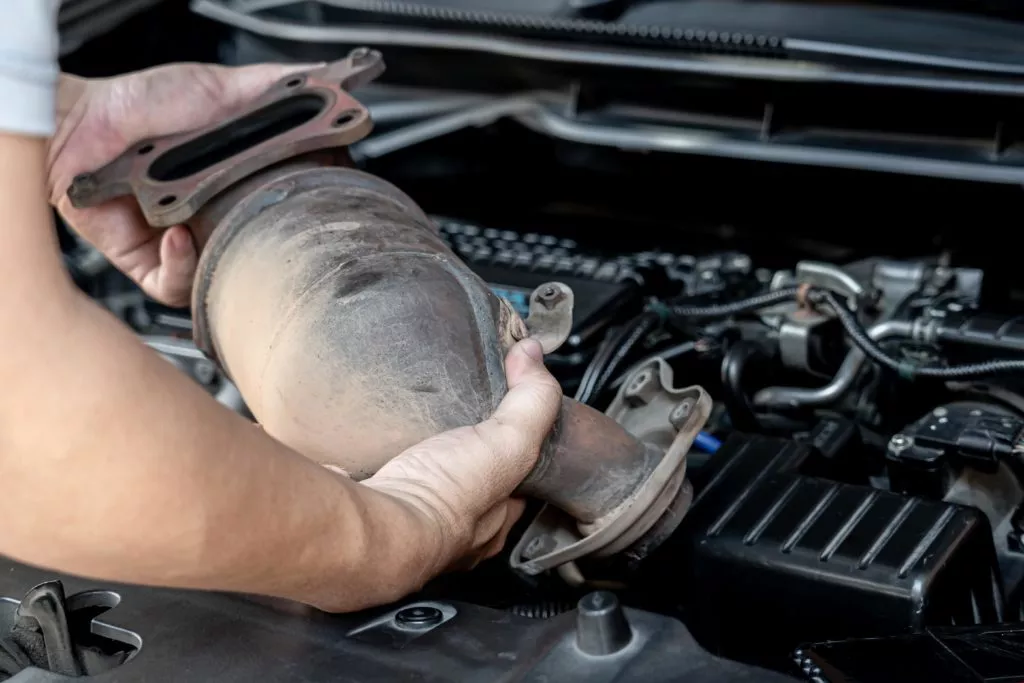What Happens When Catalytic Converter Is Removed
Reading Time: 7 minutes
The catalytic converter is tougher than most parts found in your automobile. That's because it needs that toughness to withstand high operating temperatures. But information technology can still intermission down or neglect due to rust, impact damage, or engine operation problems.
If the converter breaks downward while y'all're on the road, tin you lot go on driving your machine? Is it rubber to drive without a cat-con? How long can you drive before you lot have to replace it?
Let'southward answer some of these questions.
Driving with a Bad Catalytic Converter: Is information technology Possible?
Technically, yes. Older cars ran just fine before catalytic converters became commonplace in the 1970s. So, if your question is whether your car will run without one, so it well-nigh certainly will. But the other question you should exist asking is—should you risk it?

Beginning, what you lot need to know is that tampering with the catalytic converter in any way is illegal. You lot cannot remove or disable this component, and doing so could cost yous several thousand dollars in fines. This is especially true in states like California, which has pretty strict laws regarding vehicle emissions.
Some other problem is that removing the lite-off goad (the 1 closest to the engine) from a modern machine (newer than 1996) will trigger the check engine light due to the OBD 2 goad efficiency monitor. The light-off catalyst has an oxygen (O2) sensor backside it that measures the oxygen storage chapters of that particular converter. Six- and eight-cylinder engines will have two of these light-off converters (one for each depository financial institution), while four-cylinder engines will have only one. And for each light-off catalyst, there is an O2 sensor monitoring the frazzle stream direct behind that catalyst. Parts stores refer to this O2 sensor as a "downstream O2 sensor."
The rear catalyst isn't monitored for O2 storage and won't trigger the check engine light (MIL) if removed. Only if that catalyst is removed, it volition always crusade the vehicle to neglect emissions testing. The front catalyst handles NOx and the rear catalyst handles CO and HC emissions because the aforementioned catalyst tin can't handle all three.

So in states and cities where emissions testing is a requirement, removing either the front or rear catalytic converters will cause your vehicle to fail the emissions test. As a event, you will exist unable to get your registration renewed until the vehicle's emissions system is restored to OEM specifications.
What about a situation where the converter is intact merely non working properly? Well, that will obviously cause your vehicle to neglect emissions testing. If the powertrain control module'southward catalyst monitor function determines a monitored converter's O2 storage capacity has deteriorated, a diagnostic trouble code will be stored.
This volition also be true if the converter is clogged because the honeycomb brick has broken upwardly or gotten seriously damaged by external impact. Your car may exhibit symptoms ranging from a slight lack of power and a noticeable loss of fuel economy to a dreadfully sluggish running engine or even a no-showtime.

Typically a goad that has failed and then that it affects the fashion the vehicle performs deteriorates slowly enough that it may not be noticeable at first. Some people will ignore a balmy loss of power and/or fifty-fifty an illuminated bank check engine calorie-free and go along to bulldoze until the failure becomes severe. The indicate is that if the converter is simply suffering from a pass up in efficiency, you can continue driving without having to worry about your car breaking down. Simply you will, in states where emissions testing is required, somewhen need to take repairs done.
How Long Tin can You Bulldoze Without a Catalytic Converter?
Vehicles tin be driven without a catalytic converter. There are vehicles in not-emission testing areas that have had their catalytic converters removed, but removing a cat-con is against the constabulary in every state, even those that don't enforce emissions standards. If you remove the converter yourself (a reputable shop won't usually do this for you), just know that intentionally disabling the emission organisation on a vehicle is considered a serious offense. And the government can legally fine you many thousands of dollars for doing so.
If someone has removed your catalytic converter to sell the converter for fleck (information technology happens all the time just nearly everywhere these days), you'll know from the sound as presently equally you lot start the vehicle if the converter has been sawed off. In that case, you may be able to file an insurance claim to have the exhaust arrangement repaired, at least if your insurance will cover it.

Is it Prophylactic to Drive With a Bad Catalytic Converter?
To answer the question, let'due south begin by proverb that a missing converter and a failed converter are 2 different things. If the vehicle will run well enough to go you from point A to point B, then yep, it'due south safe to bulldoze. But catalytic converters don't always fail the aforementioned way.
If the converter has failed or is missing, safety won't be a gene. Simply you'll want to replace the converter equally soon as you discover the failure or theft. Also, never buy any vehicle that has had its converter removed unless you lot plan to repair the exhaust to brand it legal once more. After all, "safe" is a relative word. You might be physically safe, but legally unsafe.
Further, if your catalytic converter is clogged or breaking up internally to the bespeak that it'southward robbing your vehicle of power, it may not exist a proficient idea to go along driving. Driving in thick, fast traffic (like a crowded interstate near a big city) with a vehicle that doesn't perform the way it is supposed to can cause serious road accidents.
And call back, a faulty converter means increased tailpipe emissions, even if you don't see or smell anything from the exhaust. This isn't environmentally friendly. Also, carbon monoxide (ane of the three gasses the converter deals with) tin kill people in enclosed spaces. The risk is greatest when at that place are exhaust leaks and the vehicle is idling for an extended period with people inside.

And again, if the converter has mechanically failed to the betoken that information technology restricts exhaust period, information technology will cause engine operation problems. Merely there won't usually be any harm to other parts of your machine. A notable exception to the "no usual damage" statement above would exist a converter that gets extremely hot (like RED hot, which can and does happen). In that location have been parked vehicles that prepare dry out grass on fire. Remember, most fuel tanks on modern cars are plastic, equally are some of the fuel lines. That burn down-under-the-car situation is deadly and can prepare fire to the whole motorcar, not to mention the danger to people in or around it along with other cars.
What is a Catalytic Converter?
The catalytic converter is an emission control device plant in the frazzle system. First introduced in the 1970s, it quickly became standard consequence equipment on most vehicles.
Today, federal and state laws crave its presence on nearly all vehicles. Every bit previously mentioned, it'south illegal to remove, modify, or deliberately impairment the converter for any reason.
What Does a Catalytic Converter Do?
A 3-mode catalytic converter transforms iii pollutants—oxides of nitrogen, hydrocarbons, and carbon monoxide—into harmless water and carbon dioxide.

NOx is created when the combustion chamber'south "burn down" temperature rises in a higher place 2500 degrees Fahrenheit because the atmosphere is 78% nitrogen and 21% oxygen. When atomized hydrocarbon fuel is ignited in the combustion chambers, it superheats the nitrogen, causing it to aggrandize. This is what drives the piston during combustion events. However, at high temperatures, NOx is formed because oxygen becomes leap to nitrogen.
Exhaust gas recirculation (EGR) is an emissions system component that re-introduces some inert, oxygen-gratuitous gas to the intake stream while the vehicle is above idle. This cools the combustion burn to preclude NOx.
Equally for the hydrocarbon (HC), every molecule of HC wants to go "married" to two molecules of oxygen when the spark happens. Uniting the oxygen with the carbon happens when the spark triggers a combustion upshot. When the air/fuel mix is right, the aftermath of this explosion is CO2, which is the aforementioned thing people and animals breathe out.

If there is slightly as well much fuel, some molecules of HC simply get one molecule of oxygen (CO) or NO molecules of oxygen, leaving the HC to leave the engine all by itself. The catalyst breaks NOx downwardly to nitrogen and oxygen, so adds oxygen molecules to the CO and HC to catechumen them to CO2. A byproduct of engine combustion (by default) is water vapor, which is as harmless equally CO2.
The converter uses precious metals to trigger chemical reactions that change the toxic gases into safer substances without irresolute the converter itself. That'southward what a "catalyst" does.
Symptoms of a Bad or Declining Catalytic Converter
There are warning signs that your vehicle's catalytic converter has failed or is starting to neglect. They include:
- Illuminated cheque engine light
- Lack of dispatch
- Stalling
- Hard starting or a vehicle that won't start at all
In most cases, the only sign of a failed converter will be an illuminated bank check engine calorie-free. Only in instances where the converter becomes clogged or restricted, bug such as lack of acceleration, stalling, and difficult starting may occur.
To summarize, it'southward possible only illegal and potentially dangerous to drive a car with a missing or bad catalytic converter. If you must operate your vehicle before you tin can beget a replacement cat-con, effort to keep your trips cursory and drive merely to nearby locations.
Products Mentioned in this Guide
What Happens When Catalytic Converter Is Removed,
Source: https://www.carparts.com/blog/can-you-drive-without-a-catalytic-converter/
Posted by: hubbsyonson39.blogspot.com


0 Response to "What Happens When Catalytic Converter Is Removed"
Post a Comment